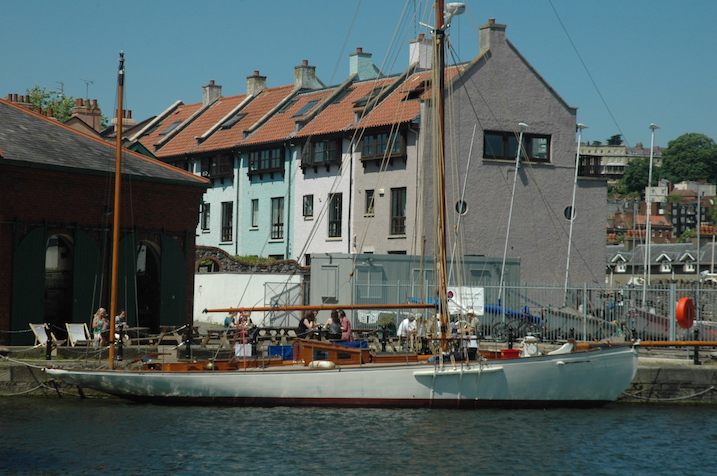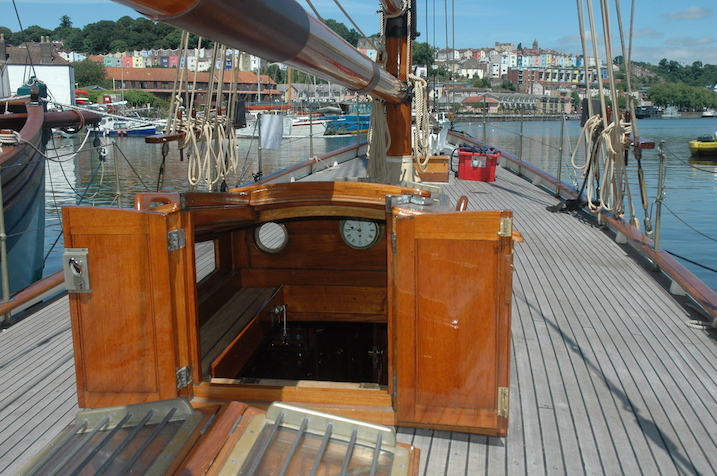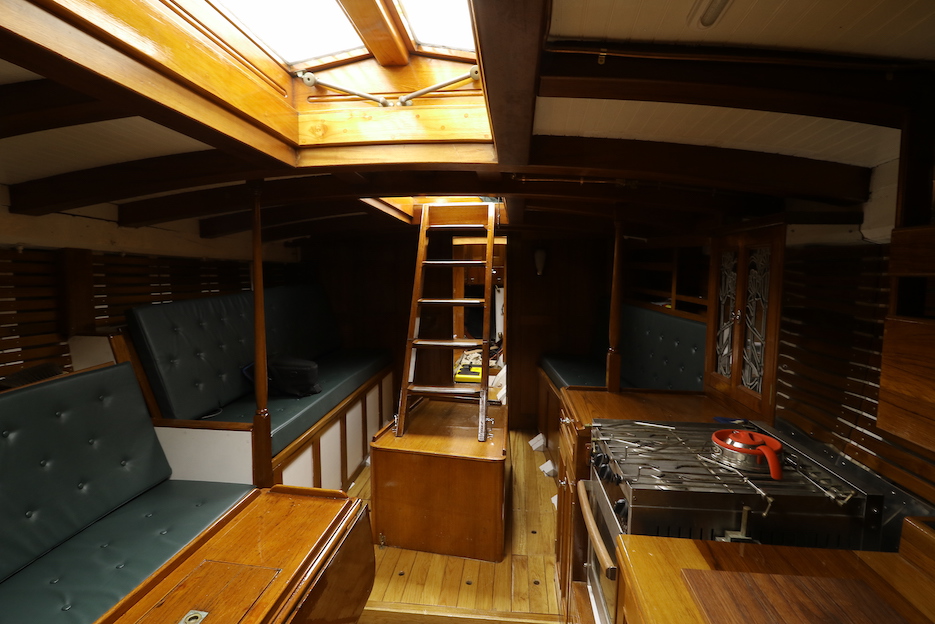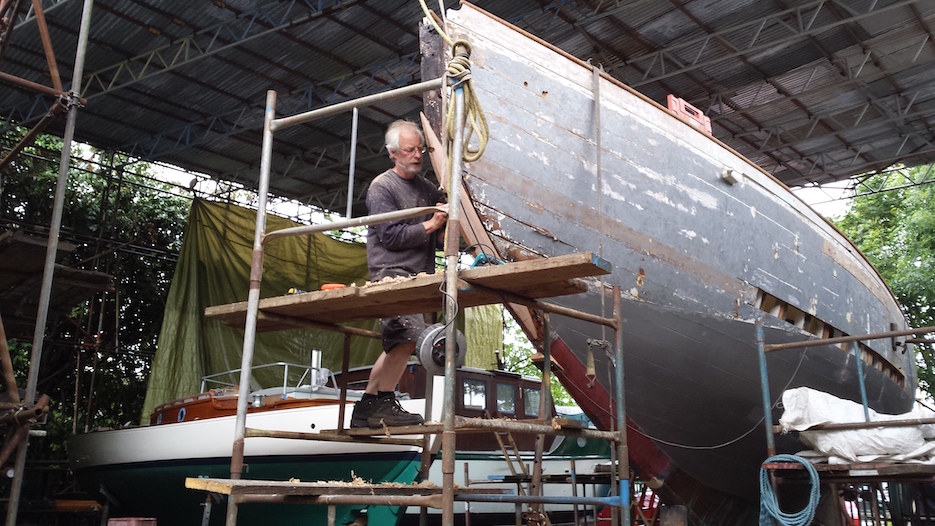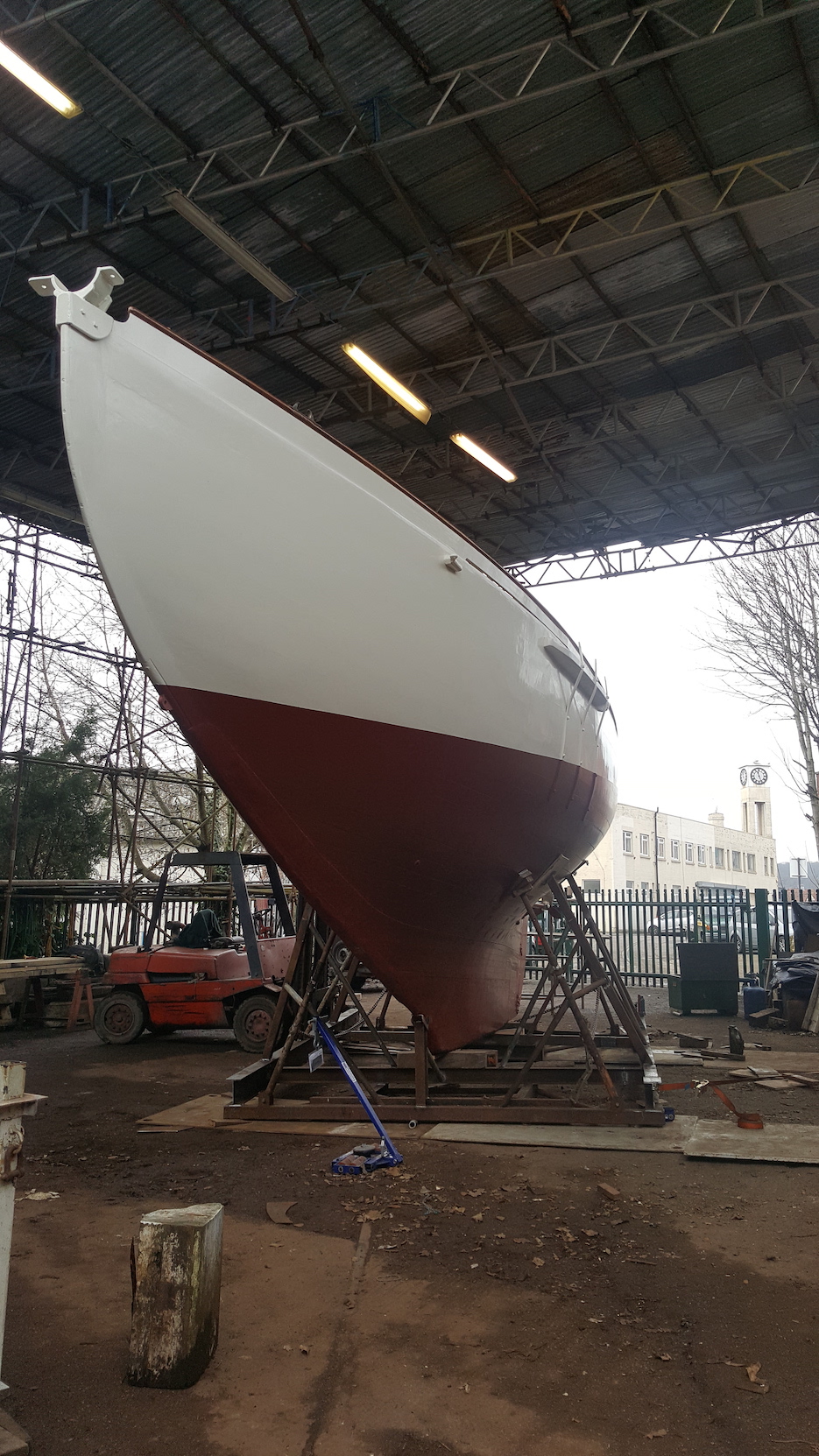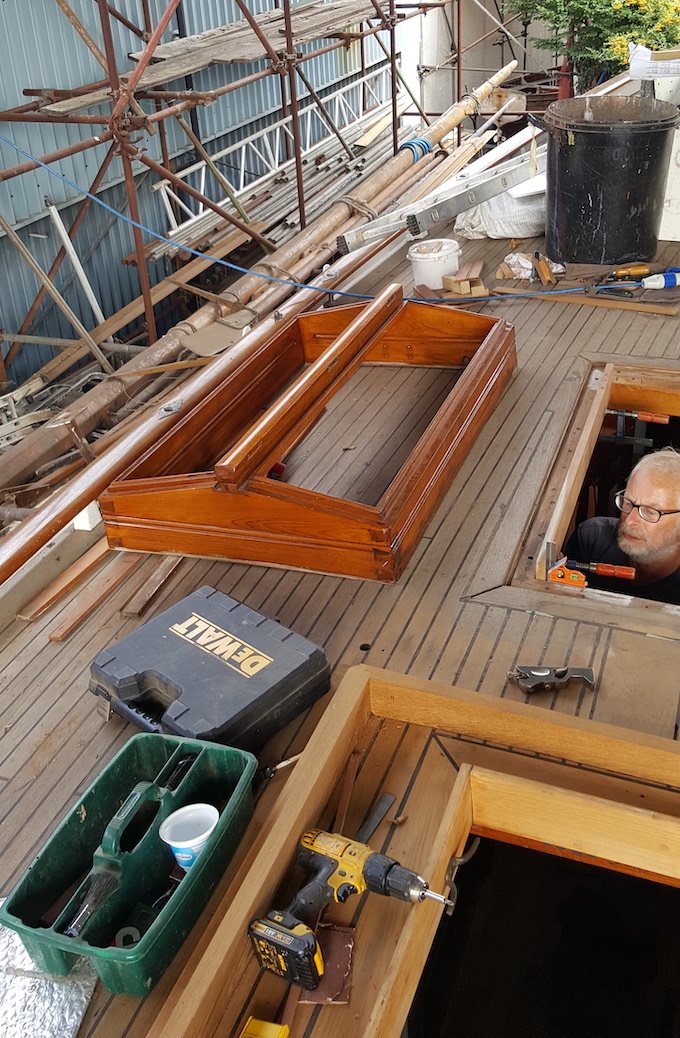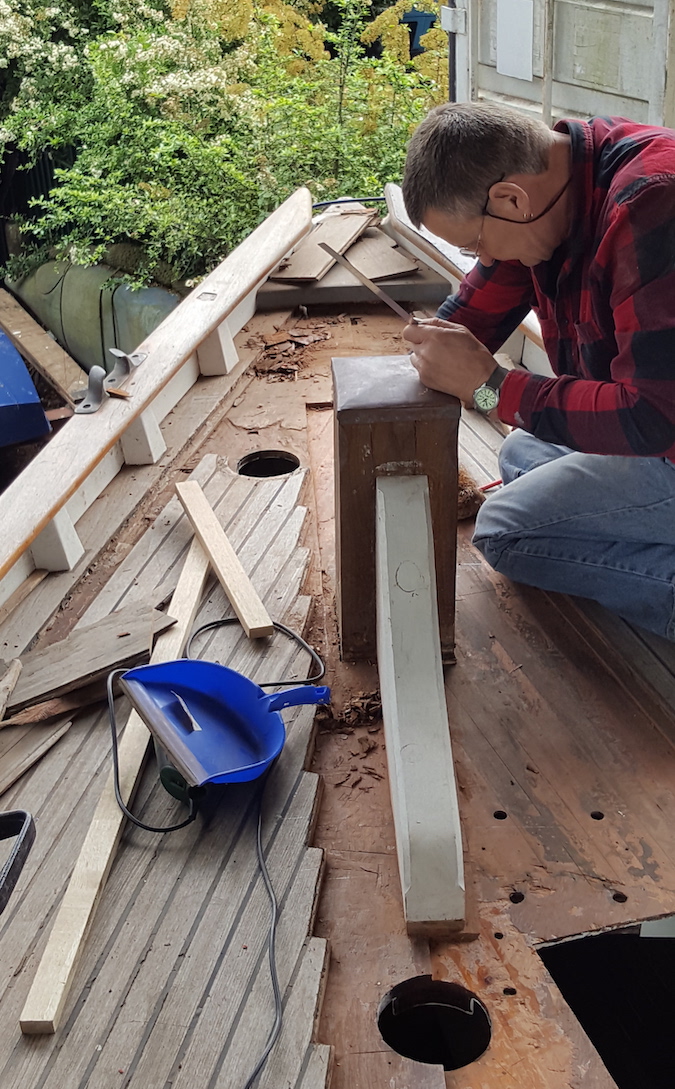Restoration of yawl Wayward by the Bristol Classic Boat Company.
Story and photos: Peter Rolt
“She looked like a tart’s boudoir inside when I found her – and it wasn’t just me that said so,” says Peter Davies. “There was no space; no thought for the people sailing her and above all no elegance. They’d completely enclosed her with cupboards in every available space, above every bunk. And the aft cabin, presumably meant for a charter boat’s professional crew, was poky and overcrowded with even a separate heads compartment where there was no room for one. So my first thoughts were to open her up properly for conversation and I think function. The brief throughout has been to return her to old fashioned simplicity and function. I wanted to end up with the look of a gentleman’s club rather than a fancy yacht. The saloon was all wrong – although I loved the table and the leaded doors to the drinks cupboard with their stained glass representation of the sea vegetable samphire – so I got the yard to strip out the saloon completely, so we could look at it afresh.”
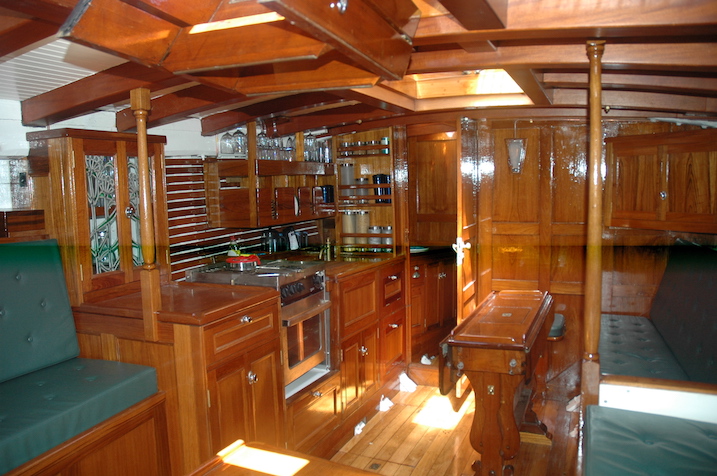
The saloon was stripped out completely before being rebuilt
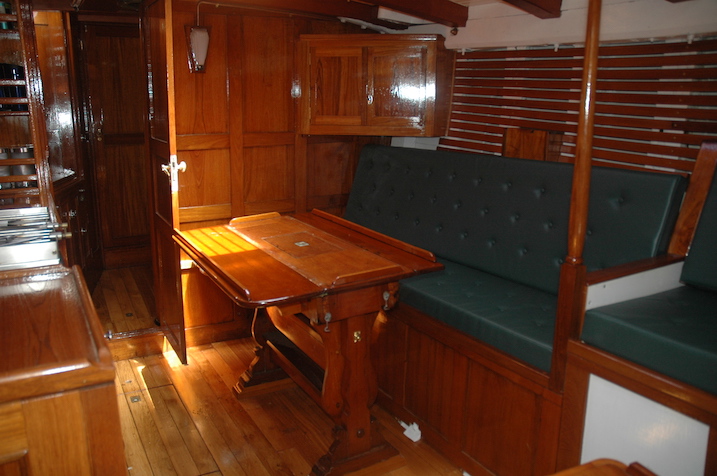
A reflection of her era: Not decadent or opulent but the feel of a comfortable smoking room
In 2010 Peter Davies had been looking for an interesting gaff rigged yacht to buy when he came across Wayward looking very sorry for herself in a boatyard on the south coast.
“She had been there for 2 years and was covered in dust. She looked very out of place, surrounded as she was by plastic boats. I had a rush of blood to the head and thought I’d take her on. She looked alright on the outside but I knew I had major work to do on her internals. It seemed logical to me to go to the boatbuilder who knew her best so I contacted Mark Rolt, formerly of Storms’l Services and now with his own outfit called the Bristol Classic Boat Company.”
Mark remembered the boat very well as her complete restoration was Storms’l Services’ first commission back in 1991.
“Peter Davies phoned me out of the blue to ask if I would be interested,” Mark remembers. ” I can’t say I wasn’t flattered. And I was intrigued by a further coincidence: Storms’l Services disbanded in 1997 after being the main workforce on building the medieval replica Matthew. I took over the Matthew‘s workshop when she sailed off to Newfoundland and I stayed at the eastern end of Bristol Harbour for the next 15 years. But when I got Peter’s phone call I was literally in the middle of moving the yard back to within a few feet of where we had rebuilt Wayward, then called Samphire, more than twenty years before.”
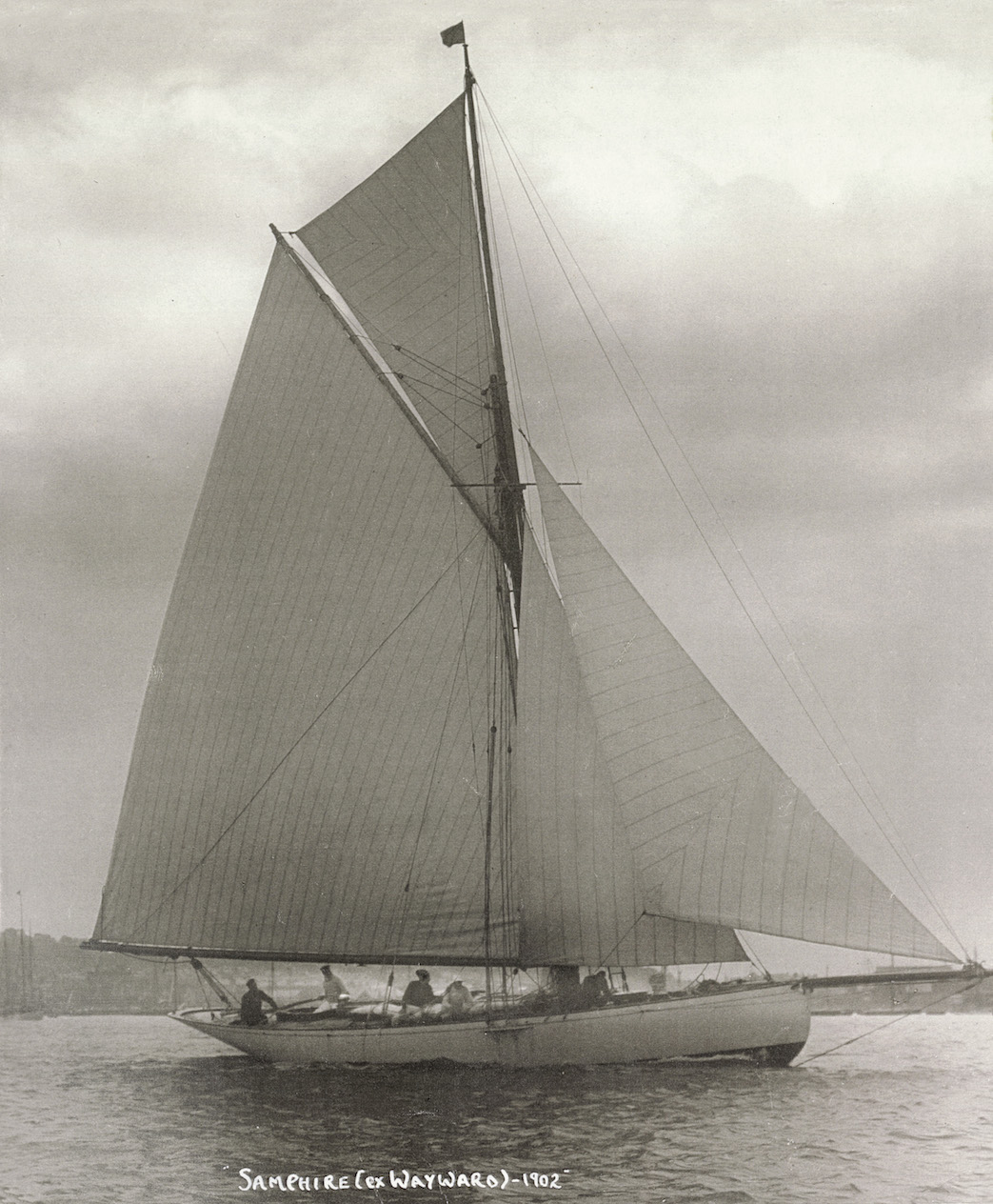
Bristol has been significant at various points in her long life. Her first name change occurred when she was owned in Bristol soon after she was built.
Wayward, a ‘gentleman’s yawl’, was launched in 1898, having been commissioned by HT Shaw (presumably a ‘gentleman’) of Beaulieu.
She was built at the Northam yard of Summers & Payne, from the drawing board of A.E.Payne who was at the top of his game. He was the equal of some of the great designers of his time and was competing for commissions with the likes of GL Watson, William Fife, JM Soper and Alfred Mylne. His father and then his elder brother had owned the yard at Northam, Southampton before him so one Payne or another had designed and built fast race winners and cruising yachts for most of the nineteenth century. The yard became Summers & Payne in 1890 before being taken over lock stock and workforce by Camper and Nicholson in the early 1900s.
Mr Shaw was a member of the Royal Yacht Squadron and after two years of racing (with unknown results) he sold her to Avery Jones of Bristol, the son of the mayor. By the time the accompanying photograph was taken she had been converted to cutter fig and renamed Samphire.
The restoration in Bristol in 1991 was comprehensive. Completely stripped below decks, she was lifted off her 8 ton lead ballast keel and put back with new bronze keel bolts. Forty per cent of her frames were replaced in oak as well as eighteen steel floors and all the hanging knees. All of her underwater planking was replaced in larch and some of her planking above – including the sheer strake – in teak. From the main companionway aft she was given new deck beams, and a new laid deck. Her bulwarks, capping rail and covering boards were entirely renewed and she got new hatches – adding a new one direct from the cockpit – as well as new hollow spars from Noble Masts, also of Bristol. She was then fitted out below, including those cupboard doors in the galley with the stained glass samphire made by Kim Gardener, and including all those bunks for charter. And off she went.
Several yards, here and in France, have undertaken refits since – including a new deck laid on new deckbeams and a subdeck of ply. Some of the work has been good but not all and the interior was over ornate with maple veneer panels and frames stuck on top of the much more attractive original teak panelling.
Wayward is now back in the water after at least seven years ashore but the majority of the work this time has not been on her hull. Although, having said that, the top of her stem needed replacing, one new teak plank was required behind her port channel, both channels were then replaced in oak and an area of the foredeck with its ply subdeck needed to be relaid. After checking her keel bolts, she has been totally recaulked, repainted and revarnished. Her masts and spars have been refurbished and revarnished and all her standing and running rigging renewed by Traditional Rigging. Her main mast has been stepped on a coin dating from the year she was built.
But the most time consuming work has been on her interior which has been almost completely reconfigured.
The work has been very much a collaborative venture between owner and boatyard. Peter Davies visited her when he could but most discussions took place by email, with Mark sending copious photos to clarify a point at issue or to update progress.
The external work was begun at the same time as the interior was almost completely removed. The bulkheads remained but the saloon was gutted apart from the galley cupboards and cooker. Over every bunk cupboards had hemmed her in so you could barely move and she looked crowded and dark.
Peter doesn’t want to cram her with charter guests and wanted her configuration below to echo her elegance of form and her pedigree as a Victorian gentleman’s racing yacht.
When the boat came in to the yard, the saloon was crowded and over ornate; now, the saloon is airy and light and open. And there is physically more room, with everything pushed back from the centreline:
“A memorable moment was when Mark phoned me to say he’d removed almost everything from the saloon except the galley cooker and the engine and he could increase her useable space athwartships by eighteen inches!”
The skylight and the companionway hatch amply light the space and much of the hull above the furniture is visible through simple teak slats that allow the boat to breathe as well as increasing the sense of space. This achievement did not come easily. Peter recognises one of the ‘breakthrough moments’ for deciding how she was to look below revolved around the heads.
When she came in to the yard she had two heads and discussions regarding the desirability for keeping both probably held up and then expedited the success of the saloon restoration more than any other thing.
“I wanted two heads,” Peter Davies told me, “and asked the yard to mock the second one up in various places. They let me reach my own conclusions on my own but eventually I said: ‘It doesn’t work,’ and Mark said, ‘No, we know it doesn’t.’ That was the breakthrough to getting the saloon right. As soon as we stopped chasing that extra head the rest slotted in to place.
“So down below I wanted a reflection of the era she was built for. Not decadent or opulent but the feel of a comfortable smoking room perhaps.”
Better than any smoking room she is light and comfortable down below with two distinct areas to sit and converse in the large saloon.
The main companionway opens on to a ladder resting on the engine box in the middle of the saloon. In front of you is the eating area – galley to port, original gimballed dining table and cushioned bench to starboard; aft of the ladder is the social area, to starboard a comfortable berth/seat whose back rest swings up to form another bunk and to port/opposite another seat with the engine box between the two as a table. The ladder swings up out of the way to work on the engine or just for a better view of who you are talking to on the other side.
The period feel is maintained by everything being in teak no modern systems being visible. The LED lamps, for instance, have their wiring fed to them via elegantly shaped copper piping.
Under your feet are oak soleboards, many simply drilled for finger holes with which to lift them.
The teak panelled bulkheads have been freed of their veneered inlays and have been painstakingly cleaned of glues to reveal simple – well, teak. Why would you want to cover it up? Where new half bulkheads have had to be built the Bristol Classic Boat Company joiner Will Jones has matched the original panelling so you cannot tell the difference. He is also responsible for the cupboard set diagonally in the corner over the seating round the table, the plate, drinks and storage racks and the quirky little fold down drinks table on the aft bulkhead (big enough for about one glass) and much more besides. I could go on but will limit myself to mentioning the lifejacket pigeonholes in the aft cabin, which seem to me to be an excellent use of space and leave no excuse for any lifejackets to be left lying anywhere else on the boat.
The aft cabin holds two quarter berths, the chart table and a good space for hanging wet weather gear. From here there is a hatch into the cockpit.
Everywhere the hull is exposed there are teak slats to hold people and belongings off the planking but equally importantly to let the air circulate and the hull planking ‘breathe’. This arrangement is practical and also contributes greatly to the feeling of space and light.
Going forward from the saloon you step in to the master cabin, panelled throughout, with a double berth over drawers to starboard and a bookcase over the foot end, well lit by a ‘lemon squeezer’ type decklight. To port is and a wide teak top with an original Victorian ceramic basin set in the middle of it. Another decklight lights this area and as usual there are slats on the hull over the sink unit, giving a sense of space that was completely lacking when that area was wall to wall shelves in her previous incarnation. A narrow hanging locker fits in the space before the door to the heads compartment which is under the forehatch. The heads to port consists of a Victorian bowl attached to a modern Jabsco unit equipped with a mascerator and plumbed to a Y-valve that takes waste either to the holding tank or the through hull skinfitting. The modern patterned ceramic basin was on the boat before and has been incorporated into the new simplified design of the compartment. It goes without saying the area above the basin and heads is finished off with teak slats. To starboard is the anchor locker, where it always was. Previously a shower head was fitted in the hatch coaming and to enter the heads you stood in the shower tray. Peter has decided she doesn’t need a shower.
Forward from this is the forepeak which is slatted throughout with rows of hooks to port for hanging ropes and sails and a small pipe cot probably more for storage or a child to sleep rather than a true extra berth. A good use of space as the samson post comes right down the middle allowing very little room to get past it.
Through the door at the aft end of the saloon is the navigation area to starboard – a chart table with Raymarine instruments and control panels fitted on hinged doors to allow access to the wiring. This is like what was there before but pushed further back from the centre line, still allowing plenty of space behind. Opposite the chart table, where there used to be tiny heads, is a simple space with hooks as a hanging locker and those oversized pigeon holes for lifejackets.
Wayward lost her original name and her original rig in Bristol at the turn of the last century. When Storms’l Services rebuilt her in Bristol in 1991 they were charged with returning her to her original yawl rig. Now, finally she has her original rig as well as her original name and Peter hopes that if Mr Shaw came on board he would recognise her, on deck and below, as his boat.
So what will she be used for and where kept?
She has a mooring off Falmouth which will be her new home. The perfect place for her. The owner plans to race her with his friends and to enjoy her, perhaps later exploring this country’s coastline in a leisurely fashion. But he also wants to give other people the opportunity to sail this old lady and has spoken to the local Sea Cadets about taking her out. “Put them on an old Victorian gaffer and have some fun. Sail her properly.”
“We’ve taken her back to being a yacht not a charter vessel.” says Peter. “I’ve paid for it but it has been a collaborative effort. A lot of people with a lot of skill have brought her back to life.” Then he smiles. “Ironically about the only thing I wanted to keep below were those stained glass cupboard doors, even if they do depict samphire and the gods of the sea have an issue with the change of name.”
On the other hand she has been called Samphire for almost her entire life so perhaps it is absolutely right that there is fitting reference to that in the heart of this 120 year old beauty.
Wayward 1898
Summers & Payne
LOA 43ft 9in (13.3m)
LOS 52ft (15.8m)
Beam 10ft 7in (3.2m)
Draught 7ft 6in (2.3m)
See more at: Bristol Classic Boat Company
Having sailed Wayward for a full season Peter Davies, her owner, now takes up the story.
Wayward remained in Bristol for the harbour festival 2017 so that people could see the skills and craftsmanship which prevails in Bristol. Her sea trial started the Monday after the festival with a 0430 slip to catch the tide out to Avonmouth, apart from runs along the floating harbour this was her first time at sea in a long time. The Avon was calm, the sun was out.

The intention was to take her around to Cornwall, gently and sedately to watch and learn how she handles and rides, checking all systems and monitor her. The trip took 38 hours, the north coast was all done on power, with an offset prop it was quite fun, she is very responsive to port, slightly sluggish to starboard and with her prop was going astern, well its quite a mystery, once astern she handles as an old maid might. We made very good time and caught all the tides we need on the run to Falmouth, as we went around Lands End we decided to take an opportunity, the main and stay had been rigged to ensure we had an alternate method to power her should anything happen to the engine, with a bright summers day and a very light wind, we decided that a test of her sails was needed, a lot of anxiety and a little huffing, the rig lifted, mail and stay set in under 5 mins, first time she had had tension in her new rig by Traditional Rigging, it set, engine into neutral and she was under sail again, now she had no offset and she creaked into life. It seemed asking for more sail to be set and keen to run on.
With only her main and a stay she made 2.5 to three knots, at this point she was alive again, Mark Rolt and his team at Bristol Classic Boats, Jay and Dennis of Traditional Rigging had; after almost 4 years bought her back to life.
So around to her new home port and her mooring off the Prince of Wales pier amongst the working boats and old timers. So, to find a crew who were going to find her abilities, or maybe the correct question was to find a crew who are going sail her to the full. She sits well, in fact she lies the same as Kindly Light, so I think in good company.
In the last 18 months Wayward has been sailing around Falmouth in the local area, in most conditions, there is no steady crew, the reason she was restored was to ensure we still have this yacht, she is for those who want to sail on her to come out and sail a gaff gentleman’s yawl, what will they find, well simply put she has impeccable manners under sail, when motoring she wants you to hoist the sail and cut the noise, a worthy approach.
Wayward has been sailed around Falmouth, in her bays and along the Cornish coast since she came back from Bristol, in all winds and weather, sea state from millpond to storms, wind from nil to gale force, throughout this she has always asked to have her head and one can feel her pulling on.
Her total rig is the Mizzen, Main, Stay, jib flying jib and topsail, when set for the wind she sails easy in the hand, balance and with no favoured tack, comfortable to sail with a short crew of three who know gaffs but to sail hard and race; she need upwards of 8, numbers not including tea monkey of course, she is happy to take seas, not a huge lean when fully weathered, but with her 21 tons you feel her move through the water, Wayward is happy dipping her gunnels and sailing through the waves, but more beautiful on a gentle sea with full rig set. Once balanced she is nothing on the helm and wants to pull on, one can set her rig as loose or tight as you desire, you need to balance the missen to stop her heading into wind, once you have the balance she is steady, with her three head sails she does not favour either tack, she does however favour sails to the engine.

We were caught out once, edged out past Pendennis Castle, forecast wind 20Kts, actual was closer to 30 with gusts above, she leant over and pulled on, she was happy to take the wind and the sea, with just her mizzen, main and a jib she made 9-10Kts, sea state 5-6, she pulled on and you could almost feel her ask to us the crew, are you good enough? she is. Normal sailing, she is responsive to her helm, no favoured tack or turn, the rig runs well and clean, well-mannered if you are under sail, fights back if you use the motor, not built with one! Once set the rig and her hull just enjoy the water and wind, dolphins seem to enjoy her noise as we normally get a few playing on the pressure wave.
She has an easy rig to control, with sheets which run to the cockpit, she is fast and in my eyes majestic. Oh yes, only two winches so a little bit of physical work to crew. The helm is light and responsive, heading up and bearing away with the same reaction.
When fully rigged, her sail area is a sight to witness, the topsail, a knotter, is a work of art, large on its yards, leaves only one question, do I blooper or not!
Wayward is used as a private yacht, welcomes anybody who would like to sail a gaff, or even just take a trip on an old rigged vessel, she is a gentleman’s yacht and I hope her restoration has captured that. This winter after 18 months on the mooring and sailing around she is out of the water and being refreshed. It is intended to get her out and about when time permits, but I hope to journey up the south coast this year. Peter Davies


